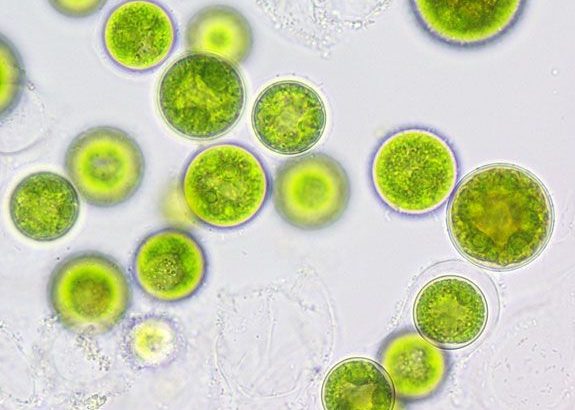Microalgae, or commonly known as phytoplankton, are autotropic organisms that use sunlight and organic nutrients. Microalgae can also be used as a source of raw materials for the pharmaceutical industry. Microalgae contain protein, vitamins and polysaccharides, antioxidants, and antibiotics that allow them to be used as additional food. Many millennial generations use microalgae to be consumed directly in the form of powdered drinks, consumed in capsules or used as face masks. As a face mask, it is beneficial for the health of the face and body skin. One of the microalgae that can produce active ingredients widely used is Dunaliella salina.
Dunaliella salina is one example of the natural source of β-carotene. Dunaliella salina has larger cells than other genus Dunaliella so that it can produce more β-carotene. Dunaliella salina is a unicellular green alga from the Chlorophyta class that can grow in a variety of environmental conditions such as low temperatures, salinity, pH and more light. Dunaliella salina can accumulate more β-carotene content when cultured under environmental stress conditions such as high salinity, low nutrition and high light. β-carotene is widely used in the food industry, as an additive dye in aquaculture and as an antioxidant in the health sector.
In this research, various experiments have been conducted to determine the increase in the content of β-carotene in D. salina due to different light intensities and to find out the best light intensity that can produce the highest β-carotene content in D. salina . So in this research deliberately cultivating these microalgae in light stress conditions to lure body cells to produce β-carotene more than normal conditions.
The microalgae are given light from a brightness of 700 Lux, 2,200 Lux, 3,700 Lux and 5,200 Lux. To produce valid data, the researcher conducted five replications in each treatment. The main parameters observed from the administration of light stressor are the production of D. salina cells produced and the content of β-carotene D. salina . Later it will be known whether there is a correlation between the beta carotene production within light stress.
From the results of various experiments, the highest light stress condition (5,200 lux) found a significant increase in β-carotene compared to other light intensities. This condition begins from 2nd day until the 8th day of cultivation. After the 8th day, the content of β-carotene has decreased. It is in line with the growth of D. salina. with light stress (5,200 lux) produces a higher cell density than normal conditions. Density begins to decrease during cultivation of D. salina. more than the 8th day.
The concept of D. salina produces chlorophyll as the main pigment acting as a photosynthetic pigment. Under normal conditions, β-carotene is produced in small amounts. When light stress is given, D. salina gets excessive light while chlorophyll production is available in a fixed amount. It encourages cells to produce additional pigments, such as β-carotene in greater amounts.
Molecularly the detailed mechanism of β-carotene production starting from the activation of signal transduction that causes changes in the arrangement of gene expression in the nucleus and cytoplasm. The product of this gene will be sent to chloroplasts, then the formation of β-carotene will occur with the help of the carotenogenesis enzyme. The carotenoid biosynthesis process begins with two GGPP molecules (C 20 ) undergoing condensation into phytoene with the help of the phytoene synthase (PSY) enzyme. Biosynthesis is followed by a phytoene desaturation reaction by the enzyme phytoene desaturase (PDS) to produce pink lycopene and 9,15,9′ -tri-cis -α-carotene, this reaction is catalyzed by two desaturases and two isomerases. The first desaturase will produce 9.9′ -di-cis– ζ-carotene with the help of carotene isomerase enzyme (Z-ISO). The second desaturase would produce 7,9,9′-cis – neurosporene and 7 ‘, 9’- cis -likopen with the help of desaturase (ZDS) enzyme. Carotene isomerase enzyme (CRTISO) will catalyze the formation of all-trans lycopene. Lycopene will undergo two cyclase reactions, by the enzyme β-cyclase (βLCY) which can produce β-carotene and the enzyme ε-cyclase (εLCY) can produce α-carotene.
This study concludes that D. salina can be stimulated to produce more beta-carotene under light stress conditions, and it is recommended to harvest after the 8th day of the cultivation process. In addition to light stress, several other factors can be examined, such as sources of stress, namely reducing nutrition and giving the salinity of extreme cultivation media.
Author: Annur Ahadi Abdillah
Details of research available at:
https://iopscience.iop.org/article/10.1088/1755-1315/236/1/012001/pdf





